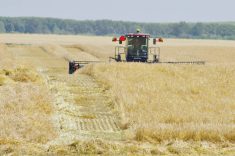Committee chair Brian Beres says the new operating procedures are supposed to be more predictable and transparent
The variety registration process for western Canadian wheat is being streamlined, but scientific merit assessment of disease resistance, agronomy and end-use quality will continue.
This and other changes overwhelmingly approved in a vote Dec. 5, 2013 by members of the Prairie Recommending Committee for Wheat, Rye and Triticale (PRCWRT), will make the recommending process more predictable and transparent, PRCWRT chair Brian Beres told the Manitoba Seed Growers Association’s (MSGA) annual meeting in Winnipeg last month.
“We are changing the way we vote because there are concerns about… predictability and that there wasn’t enough of it,” said Beres, a research agronomist with Agriculture and Agri-Food Canada at the Lethbridge Research Centre. “Part of it related to too much voting.”
Read Also

Manitoba sclerotinia picture mixed for 2025
Variations in weather and crop development in this year’s Manitoba canola fields make blanket sclerotinia outlooks hard to pin down
The new operating procedures will apply when the PRCWRT, which is made up of wheat experts from public and private institutions, including farmers, meets in Winnipeg Feb. 25 to 27 as part of the Prairie Grain Development Committee’s annual meeting.
The PRCWRT has three evaluation teams to assess new wheats for disease resistance, agronomy and end-use quality. Under the old system each committee met separately to review the data collected from replicated trials and then voted by a show of hands on whether new varieties should be recommended for registration. Then all three teams would meet and vote again through a secret ballot.
Now the evaluation teams will continue their assessments, but if all three agree a new wheat meets the standard, it will be recommended to the Canadian Food Inspection Agency for registration without the committee as a whole voting.
Similar to canola
“So some of these varieties won’t actually ever be voted on,” Beres said. “It will be similar to the canola model where it will be plugged into a merit-assessment tool. If it looks good it is endorsed without voting and if all teams endorse it then it’s recommended for registration without a vote. I think that’s a pretty good way to go because that doesn’t lessen the science and the merit behind that decision.”
If the new system had been in place in the past about 85 per cent of new wheats would’ve been recommended without a vote.
Under the new system varieties that get a mixed review from one or more of the evaluation teams will go before a voting panel, which will reassess the data and hear arguments by the variety’s breeder or representative about why it should be recommended. The panel will then vote on whether to recommend the variety or not. A similar process is used for canola, Beres said.
The 23-member voting panel will be made up of seven representatives from each team, plus one representative each from the Canadian Seed Growers Association and the Canadian Seed Trade Association.
Critics of the old process argued a system based on voting could be politicized and subjective.
“I think it (the old process) was a pretty democratic system that we had with a secret ballot, but I also understand the concerns about predictability so we’ve moved in that direction as part of the consensus,” he said.
One weakness under the old process was crop disease experts were underrepresented, he said. The new process fixes that.
Concerns have also been raised about the PRCWRT committee’s membership. Some perceived it to be dominated by government officials, who were viewed as “regulators,” Beres said. In fact the government members are experts and make up about half of the committee.
“If you break things out like that, I think it’s quite balanced actually the way it is at present,” he said.
Site-years
Under the new system wheats will require 24 site-years of data collected over three calendar years, instead of four years of data.
Up to four site-years of foreign data will be acceptable if it’s collected in American states adjoining a Prairie province.
New varieties will be assessed for five diseases instead of seven. The diseases are: fusarium head blight, leaf, stem, and stripe rusts and common bunt.
Canada has a unique variety registration system for wheat, Beres said.
“What that means is when that variety is released in Canada you already have a performance package that’s ready for the farmer, or the sponsoring agency has a higher rate of confidence to predict performance within a certain agro-eco zone,” Beres said. “At the same time the CGC (Canadian Grain Commission) has also determined what the market class is for that (variety).”
Last February Agriculture Minister Gerry Ritz wrote all the variety recommending committees asking them to evaluate their procedures and find ways to streamline the process.
Ritz doesn’t want the regulatory system discouraging the availability of new superior wheats to Canadian farmers.
Wheat industry officials were also invited to submit their recommendations for improving the registration process by Nov. 30, 2013.




















